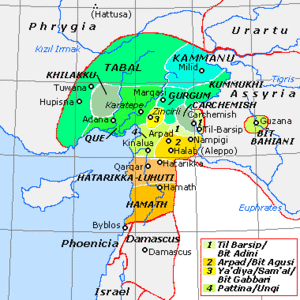Tell Afis
تل آفس | |
| Alternative name | Hazrek of Luhuti |
|---|---|
| Location | Idlib Governorate, Syria |
| Coordinates | 35°54′18″N 36°47′55″E / 35.905°N 36.798611°E |
| Type | settlement |
| Site notes | |
| Excavation dates | 1986–2010 |
| Archaeologists | Stefania Mazzoni and Serena Maria Cecchini |
| Condition | ruins |
Tell Afis is an archaeological site in the Idlib Governorate of northern Syria, and lies about fifty kilometers southeast of Aleppo.[1] The site is thought to be that of ancient Hazrek (or Hazrach; Hatarikka for the Assyrians) capital of Luhuti.[2]
History
Occupation of the site is stretching from the fourth millennium BCE to the Neo-Assyrian period.
Late Bronze
Around 1350 BC, the Hittite ruler Suppiluliuma I gain control over the northern parts of Syria. This region was then called Nuhasse.
Levels VII to V have been firmly dated to the time of control by 13th century BC Hittite ruler Hattusili III by seals, pottery, and several tablets.[3][4]
Iron Age
In Iron Age I the site was a small settlement. In Iron Age II Tell Afis grew to substantian size and was part of the Kingdom of Hamath. The Stele of Zakkur, dated c, 785 BC, which contains a dedication in Aramaic to the gods Iluwer and Baalshamin, was discovered here in 1903.[5][6] A sizable Iron Age II cultic area was discovered to the east of Temple A2, on the eastern acropolis. In Building G, 25 meters to the east of the sacred area, a pottery shard marked "LWR" was found. It was speculated that they were three letters of the god of Hazrek El-we.[7] Three additional Aramaic fragments were later found.[8] In Iron Age III the site was occupied by the Neo-Assyrian empire.
Archaeology
The tell is 28 hectares in area (570 meters by 500 meters) with an extensive lower city and an acropolis on the northern edge.[9] In 1932 William F. Albright collected Iron Age pottery in a surface collection.[10] In 1970, 1972, and 1978 excavations were conducted by Paolo Matthiae.[11] The site was excavated from 1986 until 2010 by a joint project from the universities of Rome, Pisa and Bologna, under the direction of Stefania Mazzoni and Serena Maria Cecchini.[12][1][13]
The site was reportedly damaged by encampments during the Syrian civil war.[14]
See also
References
- ^ a b Venturi, F., "La Siria nell’Età delle Trasformazioni: Nuovi Contributi dallo Scavo di Tell Afis", Cooperativa Libraria Universitaria Editirice Bologna, 2007
- ^ I. E. S. Edwards; Cyril John Gadd; Nicholas Geoffrey Lemprière Hammondpage (1970). The Cambridge Ancient History: Early History of the Middle East. Part 2, Volume 1. p. 282. ISBN 9780521077910.
- ^ Alfonso Archi, and Fabrizio Venturi, "Tell Afis in the Thirteenth Century BC: Under the Rule of the Hittites", Near Eastern Archaeology, vol. 76, no. 4, pp. 214–22, 2013
- ^ Archi, Alfonso, and Fabrizio Venturi, "Hittites at Tell Afis (Syria)", Orientalia, vol. 81, no. 1, pp. 1–55, 2012
- ^ J. C. L. Gibson, Textbook of Syrian Semitic Inscriptions: II. Aramaic Inscriptions, Oxford University Press, 1975 ISBN 9780198131861
- ^ Soldi, Sebastiano, "Aramaeans and Assyrians in North-Western Syria: Material Evidence from Tell Afis", Syria, vol. 86, pp. 97–118, 2009
- ^ Serena Maria Cecchini, "Tell Afis in the Iron Age: The Official Buildings on the Eastern Acropolis", Near Eastern Archaeology, vol. 77, no. 1, pp. 58–63, 2014
- ^ Maria Giulia Amadasi Guzzo. “Tell Afis in the Iron Age: The Aramaic Inscriptions.” Near Eastern Archaeology, vol. 77, no. 1, 2014, pp. 54–57
- ^ Michele, Angelo Di, "Tell Afis Area N. Excavations Seasons 2001-2007. Phases XI-I. Middle Bronze Age - Iron Age I. Stratigraphy, pottery and small finds", Le Lettere (Studi di Archeologia Siriana 7), 2022 ISBN 9788893663014
- ^ W. F.Albright, "Archaeological and Topographical Explorations in Palestine and Syria", Bulletin of the American Schools of Oriental Research, vol. 49, pp. 23–31, 1933
- ^ P. Matthiae, "Sondages à Tell Afis (Syrie), 1978", Akkadica, vol. 14, pp. 2–5, 1978
- ^ Venturi, Fabrizio, Tell Afis. The Excavations of Areas E2-E4. Phases V-I. The End of the Late Bronze/ Iron Age I Sequence. Stratigraphy, Pottery and Small Finds. (Firenze, Studi di Archeologia Siriana 4, Le Lettere, 2020) ISBN 978-88-9366-127-0
- ^ Stefania Mazzoni, "Tell Afis: History and Excavations", Near Eastern Archaeology, vol. 76(4), pp. 204-212, December 2013
- ^ Cunliffe, Emma., Damage to the Soul: Syria's cultural heritage in conflict, Durham University and the Global Heritage Fund, 1 May 2012
Further reading
- Serena Maria Cecchini, "TELL AFIS IN THE IRON AGE: The Official Buildings on the Eastern Acropolis", Near Eastern Archaeology, vol. 77, no. 1, pp. 58–63, 2014
- CIAFARDONI, Paola., "TELL AFIS: UN INSEDIAMENTO DEL FERRO NELLA REGIONE DI IDLIB", Egitto e Vicino Oriente, vol. 10, no. 2, pp. 5–23, 1987
- Amadasi Guzzo, Maria Giulia, "Un Fragment de Stèle Araméenne de Tell Afis", Orientalia, vol. 78, no. 3, pp. 336–47, 2009
- Mazzoni, Stefania, et al., "TELL AFIS (SIRIA) 1994 – RAPPORTO PRELIMINARE", Egitto e Vicino Oriente, vol. 18, pp. 243–306, 1995
- Mazzoni, Stefania, et al., "TELL AFIS (SIRIA) 1999", Egitto e Vicino Oriente, vol. 22/23, pp. 5–103, 1999
- Mazzoni, Stefania, et al., "TELL AFIS (SIRIA) 2000-2001", Egitto e Vicino Oriente, vol. 25, pp. 5–108, 2002
- Mazzoni, Stefania, et al., "TELL AFIS (SIRIA) 2002-2004", Egitto e Vicino Oriente, vol. 28, pp. 4–210, 2005
- Merluzzi, Emanuela, "Un tripode in basalto da Tell Afis. Origine ed evoluzione dei recipienti litici a tre piedi cerimoniali e/o rituali", Egitto e Vicino Oriente, vol. 25, pp. 231–67, 2002
- Venturi, Fabrizio, "Un vase zoomorphe du Fer I à Tell Afis (Syrie)", Syria, vol. 88, pp. 251–63, 2011


